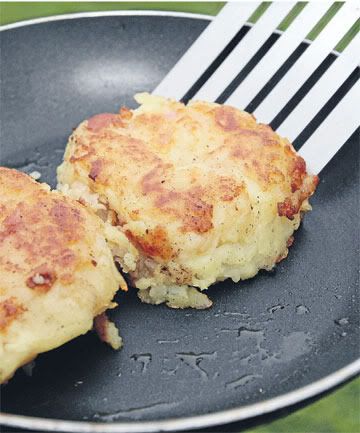Post by Deleted on Sept 29, 2012 14:05:43 GMT 10
Taking up the challenge of the humble spud
By GRAHAM HAWKES - The Southland Times | 10:10AM - Monday, 26 September 2011

DELICIOUS: Rosti potatoes — also known as mock whitebait
patties in the Hawkes’ household — offer a different way to
serve potatoes. — JOHN HAWKINS/The Southland Times.
AT THIS time of the year a daily challenge can be thinking of a different way to serve potatoes.
Since we've usually had enough of New Zealand's favourite starch either mashed, roasted or baked, a fresh style is always appreciated.
During my training years at the Otago Polytechnic our tutor informed us that by the time we finished our apprenticeship we should be able to serve the potato a different way every day of the year.
That in itself is not hugely difficult: the essential is understanding which potato to serve at the appropriate period and, more importantly, which variety to use to achieve the best result with the appropriate cooking style.
Potatoes are one of the few vegetables native to the New World, probably originating in the South American Andes. Botanically, potatoes are succulent, non-woody annual plants and members of the nightshade family.
The portion we consume is the tuber, the swollen fleshy part of the underground stem.
Potatoes are hardy and easy to grow making them inexpensive and widely available throughout the world. Having been a staple for around 200 years and enjoyed by 97 per cent of New Zealanders (more than half of them consuming the vegetable four times a week) finding another way of presenting them is guaranteed to please.
When buying potatoes, always choose ones that have been grown close to you whenever possible. Potatoes vary according to the region and the season they are grown in.
Choose potatoes without cuts, bruises, green patches or shoots. At times you may choose a smooth-looking potato over a misshapen one and assume that is a better product. This is not necessarily the case as some varieties characteristically have skins that are netted or have eyes in them.
A potato does not have to look good to work brilliantly. Different potatoes will cook differently so you need to select a potato suited to your end use.
However, the same variety will sometimes cook differently. Generally, potatoes are marked as boiling, salads, wedges or baking and I guess that is a reasonable enough guide.
If the potato does not perform the way you predict, then it will be necessary to change the way you prepare it, or change your cooking method.
The other option is to understand whether the potato is floury or waxy. Some potatoes are less floury or less waxy than others. These potatoes are general purpose ones and will tend to perform most tasks, although perhaps not as well as the ones that clearly fall into the floury or waxy category.
As the season progresses, potatoes change. For example, an Ilam Hardy early in the season is quite waxy. As the Ilam Hardy gets older, it is a good general-purpose potato; towards the end of the season, when more of its natural sugars have converted to starch, it tends to be floury. Not all potatoes will show such a range of characteristics. Weather, climate and soil have a dramatic effect on the cooking performance of the potato.
A locally grown Nadine maybe very waxy, while a Pukekohe-grown Nadine may be only slightly waxy.
The flavour is also influenced by the same factors. As a guide, Draga, Nadine and Frisia and most early new-season varieties would be classified as waxy. Ilam Hardy, Red Rascal, Agria would be more commonly known as floury.
Waxy potatoes are ideal for boiling, salads, casseroles and soups, while floury are ideal for mashing, wedges, roasting, chips and baking. Rua and Desiree would be the most common general-purpose potatoes available at present.
So this week let's look at a dish that utilises a floury potato and brings back memories of 83 Harvey St in my younger years.
Often on a Friday night we were served what my parents called mock whitebait patties. They were in fact a potato fritter, which we found absolutely delicious and always looked forward to.
______________________________________
POTATO FRITTER (ROSTI POTATO)
Ingredients: (makes about four fritters)
- 4 large Ilam Hardy potatoes
- 2 rashers of streaky bacon
- sea salt and freshly ground black pepper to taste
- 50g lard
- 1 small onion, peeled and grated
- 50g butter
- Cook the potatoes by boiling in salted water until nearly cooked.
- Drain and allow the potatoes to cool. Once cooled, peel and coarsely grate.
- Roughly chop the bacon, cook in a heavy based pan with the onion. Once cooked, remove and add grated potato, leaving the bacon fat in the pan. Season with freshly ground black pepper and sea salt.
- Heat the lard in the same pan and add the potato mixture in handfuls. Take care not to squeeze the potatoes.
- Flatten the potato into a fritter and cook until brown and crisp (about 7 to 8 minutes) and turn. Cook on the other side until brown and crisp. Now brush the edges of the pan with the butter (this will add to the crispness and the flavour of the fritter).
- Remove from the pan and serve.

